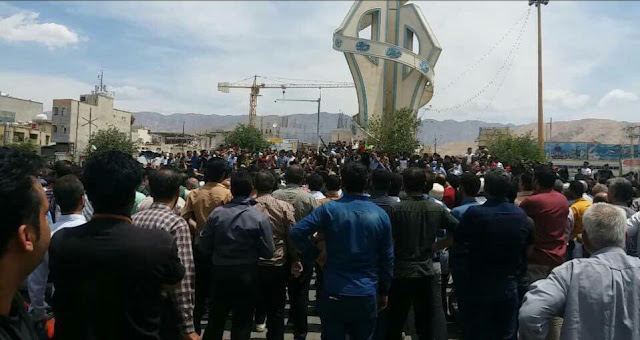As the west deliberates about dealing with Iran, take into account the desires of the people who are protesting on the streets of Iran for an end to imposed religious rule.
 Screen shot: YouTube.Iran Truck Drivers Start Nationwide Strike. May 24, 2018.
Screen shot: YouTube.Iran Truck Drivers Start Nationwide Strike. May 24, 2018.For the seventh consecutive day on Monday, Iranian truck drivers disrupted the nation's transportation system and put Iran's already struggling and decrepit economy in a stranglehold.
On the face of it, the truckers are just one of many sectors of Iranian society who have risen in protest. Joining the victims of insolvent Iranian credit unions, teachers unions, bus drivers, metro workers, students, as well as adherents of various Sufi orders, and also political prisoners and their families, the truckers are striking a chord of dissent and resistance to regime authority in Iran.
On Tuesday initially truck drivers in over 22 cities spanning all of Iran launched a nationwide strike to protest excessive road haulage taxes, high cost of spare parts, and low wages. The move was in response to an increase in road fees in some parts of the country, and low wages. Drivers demanded a 50% increase in wages to match Iran's inflation rate and high costs of living.
The Road Maintenance & Transportation Organization tried to mollify drivers by announcing a 20% increase in their wages. The truckers demanded that the fees be rescinded and wages increased further.
The strike quickly spread to over 177 cities in 29 provinces and caught Iran's security forces off guard. Thousands of truckers refused to transport loads or accept new loads. Major arteries and highways have been blocked by parked tractor trailers. Fuel shortages and long lines at petrol stations have been reported in all major cities now as fuel tankers have stopped deliveries.
Extensive social media coverage of the strike has demonstrated the strike's organization, expansiveness, staying power, and radicalization.
What was initially a one or two day protest action has now dragged into its seventh day. Video has surfaced in social media of State Security Forces attacking striking truckers but to no avail. In some videos that have been circulating in Twitter, trucks with police and military escorts are shown being stopped and forced to the roadside by striking truckers who admonish the drivers for breaking the strike.
On Friday, minivan drivers in Shiraz and Yazd joined the trucker strike in solidarity and to protest low wages.
Import and export operations in many border and customs agency locations have slowed down to a crawl or halted.
The united strike of Iranian truckers follows an almost month-long uprising in the city of Kazerun, starting on 16 April, where protestors defied all regime security measures and shouted for regime change. The Kazerun protests began seemingly in protest at rules over new districts in the region. This follows on the heels of the recent nationwide uprising in late December and early January that shook Iran.
It would be a mistake to view the events of the last few months in Iran as isolated or purely economic grievances. What is evident is that there is an organizational hand in the protests. Iran's leader, Ali Khamenei, has alleged that a triangle of actors are backing his regime into a corner and seeking its overthrow: The US government, regional allies, and the Iran opposition MEK movement (
ISNA news agency, 9 January 2018).
Though Khamenei's finger-pointing at the US and regional allies is politically motivated for domestic consumption, his highlighting of MEK's organizational role in the protests warrants close attention. The
MEK, and its umbrella organization,
National Council of Resistance of Iran, have announced the formation of local resistance chapters and councils in all Iranian cities and towns, directing protest actions on a day to day basis. Their
ten-point plan for a future Iran has garnered widespread support and Iranian protesters increasingly align their chants and slogans with this plan.
As the west deliberates on various strategies towards dealing with Iran, it’s important to take into account the desires of the people who are protesting on the streets of Iran for an end to imposed religious rule.
This
article was first published by opendemocracy






Comments
Post a Comment